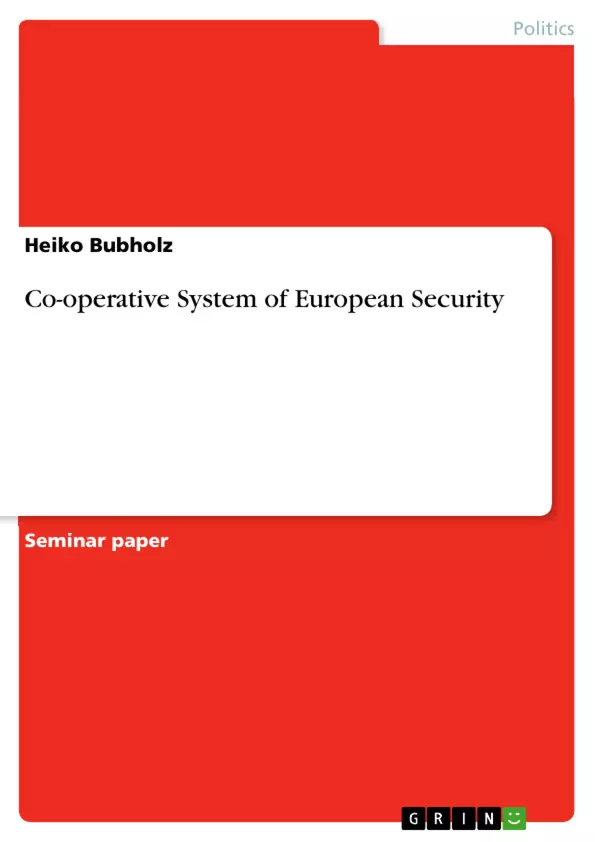The process of European integration makes significant and visibly progress. Only few months ago a considerable number of European citizen decided enthusiastically to adapt the new € currency, while the procedure and negotiation towards the eastward enlargement of the Community produces predominantly positive news. At latest with the Council Meeting of Laeken it had been concluded that a major step of the enlargement – and thus an unprecedented step in Europe’s history – might be accomplished in 2004 [1]. Nonetheless, the events of two recent wars on the Balkans (Bosnia and Kosovo) and the consciousness of Europe’s inability to cope with these local conflicts prevails still in the collective memory of most of European political and military leaders. After the end of the Cold War the today’s security scenario is lacking the – to certain extent healthy – superpower polarity of the good old days that often served to impose tense order in a confrontational world. Intra-failed-state and regional conflicts are now joining with local instability and insurgencies, which may define the most likely forms of upcoming armed conflicts in Europe or its near periphery[2].
Thus, aim of this paper shall be to elaborate a feasible and predictable scenario of European future security policy and its accompanying means. To the purpose of this discussion it deems necessary first to identify where Europe is, or where it ends, and what should be considered indispensable for a European security model. Correspondingly, there are already a number of international organizations in existence, which solely may already provide sufficient security to what is considered of Europe’s interest. Part of this paper shall be the evaluation if these existing institutions. This should allow for some recommendations, which ought to be the last part of this discussion.
[...]
Inhaltsverzeichnis (Table of Contents)
- Introduction
- Defining Europe and Europe's interests
- Europe's interests
- The Periphery
- United States and Europe's security
- Europe's relationship to Russia
- Security Architecture of Europe
- North Atlantic Treaty Organization (NATO)
- The objectives and legal basis of the Alliance
- The evolution of the Atlantic Alliance
- Organisation for Security and Cooperation in Europe (OSCE)
- United Nations (UN)
- Council of Europe (CoE)
- European Union as an emerging player
- ESDP and EU Military Structure
- North Atlantic Treaty Organization (NATO)
- A Co-operative System of European Security
- Conclusion and Outlook
Zielsetzung und Themenschwerpunkte (Objectives and Key Themes)
This paper aims to develop a realistic and predictable scenario for Europe's future security policy and its associated means. The discussion begins by examining the geographical scope of Europe's interests and identifies the existing international organizations that might already provide sufficient security for these interests. The paper concludes with recommendations based on the evaluation of these institutions.
- Defining Europe's interests and geographical boundaries
- Analyzing the security architecture of Europe
- Evaluating the role of existing international organizations in European security
- Proposing a cooperative system of European security
- Exploring the future of European security policy
Zusammenfassung der Kapitel (Chapter Summaries)
The first chapter introduces the paper's scope and objectives, highlighting the ongoing process of European integration and the challenges posed by recent conflicts in the Balkans. It emphasizes the need for a comprehensive approach to European security in a post-Cold War context.
Chapter two explores the concept of Europe's interests, asserting that Europe extends beyond the current boundaries of the European Union. It examines the historical, political, and economic factors that define Europe's common interests, emphasizing the importance of maintaining peace and security within the continent.
Chapter three delves into the existing security architecture of Europe, analyzing the roles and responsibilities of key international organizations such as NATO, OSCE, UN, and the Council of Europe. It examines the evolution of these organizations and their contributions to European security.
Chapter four discusses the potential for a cooperative system of European security, examining the emerging role of the European Union in security matters and exploring the potential for a more integrated and collaborative approach.
Schlüsselwörter (Keywords)
The paper focuses on key concepts such as European integration, security architecture, cooperative security, international organizations, European Union, NATO, OSCE, UN, Council of Europe, and the challenges of maintaining peace and security in a changing world. It also examines the evolving role of the United States and Russia in European security.
- Arbeit zitieren
- Heiko Bubholz (Autor:in), 2002, Co-operative System of European Security, München, GRIN Verlag, https://www.grin.com/document/6241



